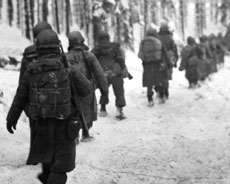Cold Injuries

Photo: U.S. Department of Defense
Service members may have been exposed to extreme cold in combat and military training missions. The major cold injuries they could suffer from include frostbite, non-freezing cold injuries, immersion foot (formerly called trench foot), and hypothermia.
The risk of cold injury depends on several environmental conditions including temperature, wind and moisture, in combination with physical activity, the duration of exposure, and amount of protection. The individual’s level of fitness and cold susceptibility also contribute to the risk.
If you are concerned about health problems associated with cold injuries, talk to your health care provider or contact your local VA Environmental Health Coordinator to help you get more information from a health care provider.
How Veterans may have had cold injuries
Veterans may have been exposed to extreme cold without adequate protection during:
- World War II: The Battle of the Bulge, fought in December 1944 through January 1945 under conditions of extreme cold
- Korean War: The Chosin Reservoir Campaign, conducted from October 1950 through December 1950 in temperatures that dropped to 50 degrees F below zero, with a wind chill factor of 100 degrees F below zero.
- Operation Enduring Freedom (OEF) in Afghanistan
- Other campaigns or circumstances during military service, including training.
Health problems associated with cold injuries
Cold injuries may result in long-term health problems, including the following signs and symptoms (at the site of exposure):
- Changes in muscle, skin, nails, ligaments, and bones
- Skin cancer in frostbite scars
- Neurologic injury with symptoms such as bouts of pain in the extremities, hot or cold tingling sensations, and numbness
- Vascular injury with Raynaud’s Phenomenon with symptoms such as extremities becoming painful and white or discolored when cold
Health concerns?
If you are concerned about health problems associated with cold injuries during your military service, talk to your health care provider or contact your local VA Environmental Health Coordinator to help you get more information from a health care provider.
VA offers a variety of health care benefits to eligible Veterans. Not enrolled in the VA health care system? Find out if you qualify for VA health care.
Compensation benefits for health problems
Veterans may file a claim for disability compensation for health problems they believe are related to cold injuries during military service. VA decides these claims on a case-by-case basis. File a claim online.
Learn more about VA benefits.




















